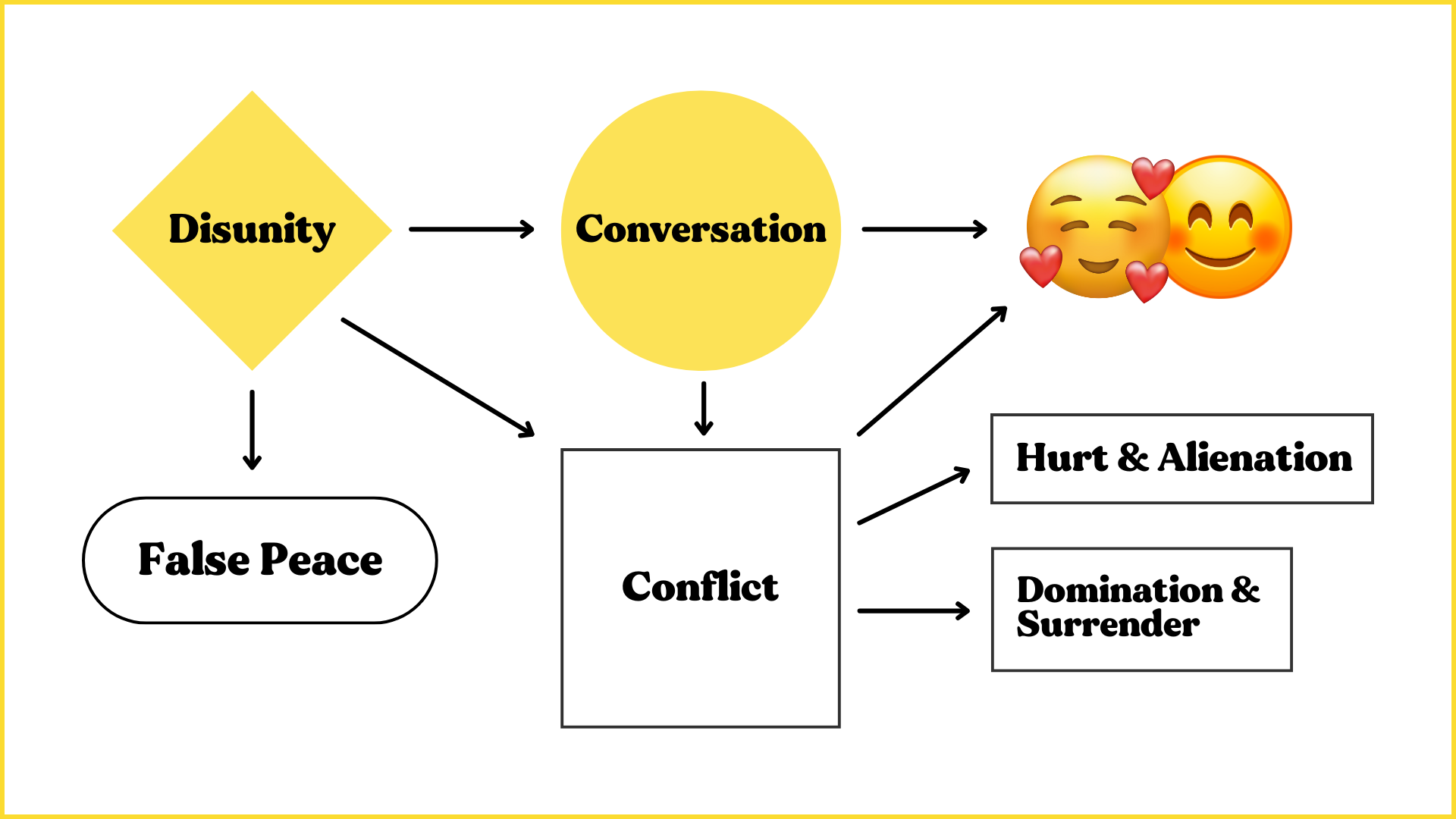The Anatomy of an Argument
How healthy conflict brings you closer - 4.5 minute read
Have you ever been in a fight and wondered how the heck you got there? Or maybe the fight ended and you’re sitting by yourself in the aftermath, scratching your head because now it all seems worse than before?
Understanding how conflict works and the impact of our choices along the way can help.
There are three main stages of an argument: Disunity, Conversation, and Conflict, and how we go about them can determine the outcome and whether or not we get closer or further apart.
Stage 1 - Disunity
This is the moment where you haven’t said anything yet, but you’re aware there’s a problem. You’re not on the same page about something.
But, if you don’t talk about it and deal with it it’s not going to get better by itself. You have a decision to make. Do you share it or keep it to yourself?
Bringing it up might disrupt the peace, but, here’s the thing… not bringing it up undermines your peace anyway.
REMINDER - The goal is not zero conflict. The goal is healthy conflict which brings us closer.
In the Disunity stage, you must make a decision:
Hold onto it and have false peace,
Start a conversation or,
Erupt into a conflict.
False Peace
We unpacked this in a previous email, so we won’t go into it too much here. Your first option is to sweep it under the rug—don’t bring it up, don’t rock the boat.
But this doesn’t fix the problem. It only elevates “PEACE” above INTIMACY.
But the point isn’t to have peace at all costs—it’s to have intimacy. So we should talk about the thing.
And the best way to do that is to start a conversation.
Stage 2 - Conversations
The best way to get on the same page is through a calm, loving, connected conversation. This is why connection is important. Connection is like oil. It makes hard conversations easier. If the connection is not there and you come in all guns blazing, you’re not starting a conversation, you’re starting a fight.
There are two big keys to starting a calm, loving, connected conversation: TIMING and APPROACH.
Let’s unpack that:
Pick a good time – maybe in the middle of dinner prep isn’t the perfect time for them. Pick your timing. Schedule it. Perhaps it can wait a couple of days. Not everything is urgent and requires immediate and total resolution. Maybe keep loving them until you’ve got the time and headspace for a conversation.
Start with a kind opener like, ‘In the interest of open communication…’ This creates immediate depth and importance of the conversation because you’re being vulnerable. This is our code phrase. Feel free to use it!
Listen to understand, not just interject. Active listening means I’m listening TO THEM and trying to understand what they mean, instead of listening to MYSELF internally rebut everything they’re saying. Ask questions, repeat back for clarification, etc.
Remember the goals of agreement and understanding. The goal is not to be right, the goal is to be together.
Be flexible and be willing to meet somewhere in the middle. Flexibility and compromise are acts of love. We adapt and change how we do things for the sake of unity and togetherness.
Know your processing styles (internal and external) - this was an early game-changer for us. Learn more here.
If you conduct the conversation well, you might be able to avoid conflict. But sometimes conflict is inevitable.
Stage 3 - Conflict
Conflict happens when an issue escalates. Often, this means we get a bit angry or frustrated, feel more emotional, feel that the conversation has hit a nerve, or grow more passionate about the result.
Either way, it’s getting heated. The conversation is escalating, and now conflict is inevitable. We shouldn’t avoid it (it leads to false peace), but we should learn how to navigate it well to get to our destination together, with the issue resolved and our relationship closer than before.
How we navigate this escalation determines how it ends.
Healthy conflict brings resolution to the issue and deeper connection and intimacy.
Unhealthy conflict leaves you with two problems. The original problem you were disagreeing about and a new problem in your relationship.
Here are the 3 general outcomes:
Hurt and alienation
Domination and/or surrender
Resolution and closeness
Hurt and Alienation
It didn’t go well. Words were said. Tone was used. You both felt misunderstood or blindsided. And now you’re feeling more distant than before it all happened. Sometimes it takes more than one or 10 conversations to resolve a big issue. That’s ok. Don’t give up.
When the argument lands here:
The original problem isn’t resolved, and you might feel further away from a solution. That’s happened to us many, many times, and still does occasionally.
Now, you also have a rupture in your relationship that needs repair. This is the second problem. One or both of you are hurting, even more than before, and you may have said things you regret. Come back together after you cool down, apologise, forgive, and reconnect.
Dominion and/or Surrender
This is where either one person dominates the other into submission or one person gives in to keep the ‘peace’ or keep them happy. But:
It’s not a healthy compromise out of love, it’s a surrender out of fear.
It’s not unity or teamwork. It’s capitulation.
There’s a power imbalance in the relationship and you’re not equals.
Intimacy is damaged, and unity is not achieved.
Resolution and Closeness
If you’re going to avoid these 2 terrible outcomes, resolve the conflict and get closer there are two big keys to consider: curiosity and kindness.
Curiosity
Stay curious even during conflict. That means you both recognise:
Both of us want things and need things here, and we are equals.
We genuinely want to understand each other better.
We want to serve and love each other well.
It’s not me vs you, it’s us vs the problem.
We both have strengths to help us navigate this together.
We may be learning things about ourselves in the middle of this conflict.
We might even be wrong!
We might also do something wrong and say things out of frustration, pain, or fear, and that’s okay.
2. Kindness
This means we keep valuing and loving the person even while we’re processing, talking and working things out. Even when it’s hard. Even when there’s emotions and hurt and misunderstandings.
We don’t always get it right every time but this is a skill you can develop.
Here’s the process in full. You can see the ideal path across the top and the other outcomes that can happen too.





